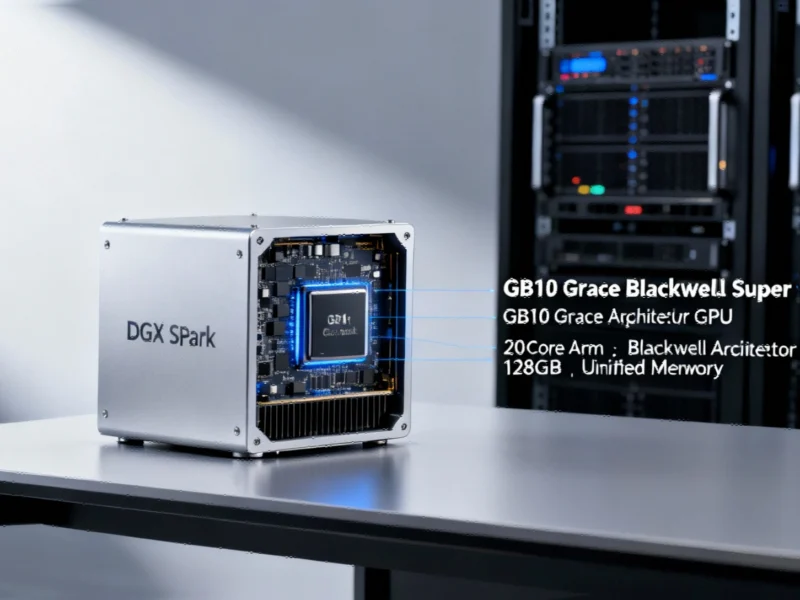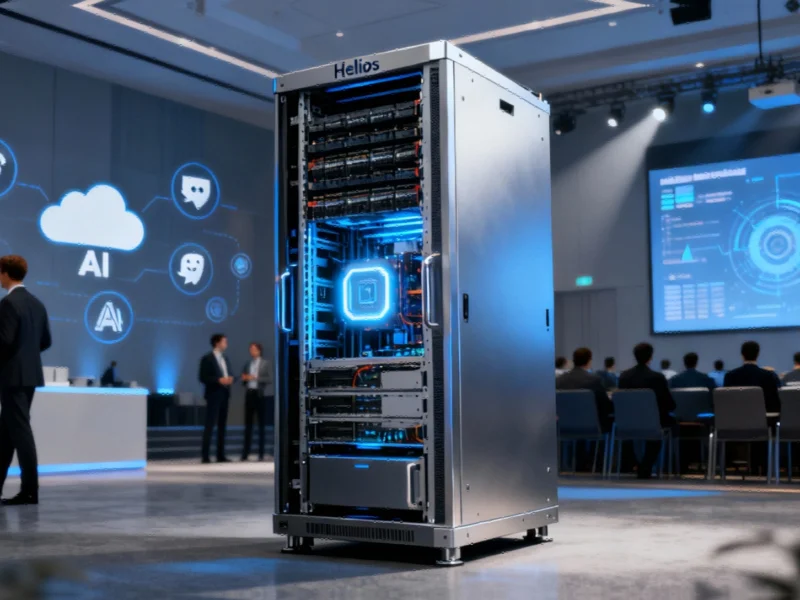Enterprise AI Development Transformed
Nvidia has fundamentally altered the enterprise artificial intelligence landscape with the commercial release of its DGX Spark system, delivering data center-class computational capabilities in a desktop form factor. Shipping commenced on October 15, 2025, with the $3,999 device placing unprecedented AI model processing power directly onto technology decision-makers’ desks. This strategic move comes as organizations increasingly transition from experimental AI projects to full-scale production implementations requiring robust local development environments.
The compact 150mm square device represents a significant departure from traditional AI infrastructure approaches. While enterprises typically rely on cloud GPU instances or dedicated server infrastructure for AI workloads, the DGX Spark introduces a compelling intermediate solution. This development aligns with broader industry trends, including AI-powered tools transforming traditional industries through enhanced accessibility and cost efficiency. The system enables comprehensive local prototyping and model refinement before production deployment, addressing the iterative development cycles essential for successful AI implementation.
Industry analysts note the timing coincides with critical market developments, including increasing enterprise demand for accessible AI infrastructure solutions that balance performance with practicality. The device’s introduction reflects Nvidia’s strategic positioning to capture emerging market segments between consumer-grade workstations and enterprise-scale data center deployments.
Architectural Innovation and Performance Capabilities
At the heart of the DGX Spark lies the groundbreaking GB10 Grace Blackwell superchip, integrating a 20-core Arm processor with Blackwell architecture GPU sharing 128GB of unified memory. This memory architecture represents a fundamental shift from traditional discrete GPU configurations, eliminating the performance overhead associated with data transfers between separate CPU and GPU memory pools. The unified approach enables the system to load entire large language models directly into memory, significantly accelerating model inference and fine-tuning operations.
The system delivers one petaflop of computational performance at FP4 precision, equivalent to 1,000 trillion floating-point operations per second. This theoretical peak performance leverages 4-bit precision and sparsity optimization specifically tailored for AI workloads. However, real-world performance demonstrates considerable variation based on model architecture and precision requirements, with independent benchmarks identifying the 273 gigabytes per second memory bandwidth as the primary performance constraint.
This bandwidth limitation becomes particularly apparent in inference workloads where memory throughput directly determines token generation speed. Comparative analysis reveals Apple’s M4 Max configuration provides 526 gigabytes per second memory bandwidth, nearly double the DGX Spark specification. Despite this constraint, the system maintains competitive positioning through its specialized architecture and software optimization.
Connectivity and Expansion Capabilities
The DGX Spark features comprehensive connectivity options spanning consumer and enterprise requirements. Storage configurations include either 1TB or 4TB NVMe options with integrated self-encryption capabilities. Networking incorporates both Wi-Fi 7 and 10 gigabit ethernet for conventional connectivity, complemented by dual QSFP56 ports connected through an integrated ConnectX-7 smart network interface card.
These high-speed ports theoretically support 200 gigabits per second aggregate bandwidth, though practical throughput faces limitations from PCIe generation 5 lane constraints. The connectivity framework enables sophisticated deployment scenarios, including distributed inference configurations where two DGX Spark units connect via QSFP ports to handle models up to 405 billion parameters. This configuration requires either direct cable connection or enterprise-grade 200 gigabit ethernet switches, with compatible infrastructure typically exceeding $35,000.
The networking capabilities position the system within broader industrial computing trends, including increasing European focus on technological infrastructure development and growing industrial computing requirements across multiple sectors.
Software Ecosystem and Operational Considerations
Nvidia’s DGX OS, a customized Ubuntu Linux distribution, provides the foundational software environment preconfigured with CUDA libraries, container runtime, and AI frameworks including PyTorch and TensorFlow. This closed ecosystem approach ensures comprehensive software compatibility and optimization but restricts flexibility compared to general-purpose workstations. Users cannot install alternative operating systems like Windows or utilize the hardware for non-AI workloads such as gaming.
Third-party testing has revealed significant thermal management challenges within the compact form factor. Sustained computational loads generate substantial heat within the 240-watt power envelope, potentially impacting performance during extended fine-tuning sessions. The system requires the specifically supplied power adapter for optimal operation, with alternative adapters causing performance degradation or unexpected shutdowns.
These operational characteristics reflect the specialized nature of the device, which aligns with increasing industry recognition for specialized computing solutions addressing specific workflow requirements.
Market Positioning and Competitive Landscape
Nvidia’s launch partners including Acer, Asus, Dell Technologies, Gigabyte, HP, Lenovo and MSI have commenced shipping customized hardware versions. Acer’s Veriton GN100 matches the reference specification at the identical $3,999 price point with regional availability across North America, Europe and Australia. Dell has positioned its version toward edge computing deployments rather than desktop development, reflecting market uncertainty about primary demand drivers.
This divergence in partner messaging highlights the evolving nature of industrial computing markets, where European markets demonstrate continued volatility amid shifting technology adoption patterns. The edge computing angle specifically targets scenarios requiring local inference with minimal latency, such as industrial automation or remote facility deployments where cloud connectivity proves unreliable.
Alternative approaches to similar computational requirements include building multi-GPU workstations, purchasing Mac Studio configurations with comparable unified memory, or maintaining cloud GPU subscriptions. Four Nvidia RTX 3090 GPUs provide greater aggregate memory and inference throughput at similar total cost, though with higher power consumption and larger physical footprint. The Mac Studio M4 Max configuration delivers 128GB unified memory with superior bandwidth characteristics starting at $4,400.
Economic Considerations and Deployment Scenarios
The DGX Spark occupies a specific operational window between laptop-class AI experimentation and cloud-scale production deployment. Organizations typically justify the investment when requiring consistent local access to large model development capabilities, facing data residency requirements preventing cloud deployment, or running sufficient inference volume to offset recurring cloud GPU costs.
Technology decision-makers must evaluate total cost of ownership including the base hardware investment, potential switch infrastructure for multi-unit configurations, and opportunity cost versus cloud alternatives. A single DGX Spark running continuously for model fine-tuning represents a $3,999 upfront investment. Equivalent cloud GPU hours vary significantly by provider and GPU type, ranging from $1 to $5 per hour for comparable specifications.
Real-world deployment scenarios include model prototyping where developers iterate on AI architectures before cloud deployment, fine-tuning of models between 7 billion and 70 billion parameters, and batch inference workloads such as synthetic data generation. Computer vision applications represent another significant use case, with organizations deploying the system for local model training and testing before edge deployment.
Adoption Patterns and Market Reception
Early adoption patterns two weeks after general availability reveal limited but strategic deployment. Initial recipients include research institutions, AI software companies including Anaconda and Hugging Face, and technology vendors conducting compatibility testing. Broader enterprise adoption will determine whether the device addresses genuine operational needs or represents a niche product for specific development workflows.
The market reception occurs against a backdrop of persistent market challenges affecting technology equities, highlighting the importance of demonstrable return on investment for new technology acquisitions. The DGX Spark demonstrates Nvidia’s comprehensive vertical integration across silicon design, system architecture and software platforms, providing organizations a tested platform for AI development with guaranteed compatibility across Nvidia’s ecosystem.
Ultimately, whether the $3,999 investment delivers sufficient value depends entirely on individual development workflows, data residency requirements and existing infrastructure constraints. The system functions optimally as a development platform rather than production infrastructure, enabling teams to prototype and optimize models locally before deploying to cloud platforms or on-premises server clusters for production inference.
Strategic Implications and Future Outlook
The DGX Spark introduction represents a strategic expansion of Nvidia’s product portfolio into the professional workstation market, bridging the gap between consumer graphics cards and enterprise data center solutions. This move potentially disrupts traditional workstation markets while creating new opportunities for organizations seeking to develop AI capabilities without immediate cloud infrastructure commitment.
Several limitations constrain adoption for specific use cases, including the memory bandwidth bottleneck reducing effectiveness for high-throughput inference applications compared to discrete GPU alternatives. The closed software ecosystem prevents workstation consolidation for teams requiring both AI development and traditional computational tasks. Organizations needing to train models larger than 70 billion parameters still require cloud infrastructure regardless of local development hardware capabilities.
As AI development continues to democratize across industries, the DGX Spark positions Nvidia to capture emerging market segments while reinforcing its ecosystem dominance. The success of this product category will depend on evolving enterprise AI workflows, competitive responses from alternative solution providers, and the continuing balance between local computational requirements and cloud infrastructure economics.
Based on reporting by {‘uri’: ‘forbes.com’, ‘dataType’: ‘news’, ‘title’: ‘Forbes’, ‘description’: ‘Forbes is a global media company, focusing on business, investing, technology, entrepreneurship, leadership, and lifestyle.’, ‘location’: {‘type’: ‘place’, ‘geoNamesId’: ‘5099836’, ‘label’: {‘eng’: ‘Jersey City, New Jersey’}, ‘population’: 247597, ‘lat’: 40.72816, ‘long’: -74.07764, ‘country’: {‘type’: ‘country’, ‘geoNamesId’: ‘6252001’, ‘label’: {‘eng’: ‘United States’}, ‘population’: 310232863, ‘lat’: 39.76, ‘long’: -98.5, ‘area’: 9629091, ‘continent’: ‘Noth America’}}, ‘locationValidated’: False, ‘ranking’: {‘importanceRank’: 13995, ‘alexaGlobalRank’: 242, ‘alexaCountryRank’: 114}}. This article aggregates information from publicly available sources. All trademarks and copyrights belong to their respective owners.



